An AI-Supported Framework for Enhancing Energy Resilience of Historical Buildings Under Future Climate Change
Abstract
1. Introduction
- Question 1: The cycles of climate over time and how they have changed until today (How these cycles have changed from the past to the present, according to palaeoclimatological data, and how the rapid changes observed today are beyond natural cycles)
- Question 2: What are the differences in how historical buildings are affected by climate change compared to other buildings? (How differences such as materials, construction techniques, and conservation policies affect the level of risk)
- Question 3: What are the possible impacts of exposure of historical buildings to climate change? (Structural risks, aesthetic, and functional losses are assessed within the framework of climate parameters)
- Question 4: What are the various components of the resilience of historic buildings against climate change? (The concept of resilience is divided into subcomponents according to various factors)
- Question 5: To what extent do existing studies integrate AI-supported methods when addressing energy resilience under climate change? (While AI is used in various sectors and energy, studies suggesting its use in the context of future climate risk are limited)
- Question 6: How can AI methods assist in resilient and predictive decision-making to reduce the impact of climate change on cultural and historical buildings? (Providing various potentials such as data-driven risk analysis, forecasting with climate scenarios, optimization of resilience strategies, decision support systems, and early intervention)
2. Literature Review
2.1. Historical Cycle of Global Temperatures
2.2. Climate Change and Climate-Related Risks
2.3. Climate Change and Effects on Cultural Heritage
3. Concept of Resilience and Components
3.1. Resilience to Climate Disasters
3.2. Energy Resilience
3.3. Sociocultural Resilience
3.4. Economic Resilience
4. Methodology
4.1. Systematic Literature Review with PRISMA Guidance
4.2. Content Analysis
4.3. AI Integration Review and Potentials
4.4. Developed Conceptual Framework and Discussion
5. Conclusions and Recommendations for Future Work
Author Contributions
Funding
Institutional Review Board Statement
Informed Consent Statement
Data Availability Statement
Conflicts of Interest
Abbreviations
| SSP | Shared Socioeconomic Pathway |
| LCA | Life Cycle Assessment |
| SDGs | Sustainable Development Goals |
| AI | Artificial Intelligence |
| ML | Machine Learning |
| ANN | Artificial Neural Network |
| NLP | Natural Language Processing |
| IPCC | Intergovernmental Panel on Climate Change |
| HVAC | Heating, Ventilation, and Air Conditioning |
References
- IPCC. IPCC, Climate Change 2022: Impacts, Adaptation and Vulnerability; C.U. Press: New York, NY, USA; Available online: https://www.ipcc.ch/report/ar6/wg2/ (accessed on 8 July 2025).
- Mitchell, D.; Heaviside, C.; Vardoulakis, S.; Huntingford, C.; Masato, G.; Guillod, B.P.; Frumhoff, P.; Bowery, A.; Wallom, D.; Allen, M. Attributing human mortality during extreme heat waves to anthropogenic climate change. Environ. Res. Lett. 2016, 11, 074006. [Google Scholar] [CrossRef]
- IPCC. IPCC, AR5 Climate Change 2014: Impacts, Adaptation, and Vulnerability. Available online: https://www.ipcc.ch/report/ar5/wg2/ (accessed on 9 July 2025).
- Nicholls, R.J.; Brown, S.; Goodwin, P.; Wahl, T.; Lowe, J.; Solan, M.; Godbold, J.A.; Haigh, I.D.; Lincke, D.; Hinkel, J.; et al. Stabilization of global temperature at 1.5 °C and 2.0 °C: Implications for coastal areas. Philos. Trans. R. Soc. A Math. Phys. Eng. Sci. 2018, 376, 20160448. [Google Scholar] [CrossRef] [PubMed]
- IEA. Perspectives for the Clean Energy Transition—Analysis—IEA 2019. Available online: https://www.iea.org/reports/the-critical-role-of-buildings (accessed on 3 July 2025).
- Maduta, C.; Melica, G.; D’Agostino, D.; Bertoldi, P. Towards a decarbonised building stock by 2050: The meaning and the role of zero emission buildings (ZEBs) in Europe. Energy Strategy Rev. 2022, 44, 101009. [Google Scholar] [CrossRef]
- European Commission. European Commission: The European Green Deal. 2019. Available online: https://commission.europa.eu/strategy-and-policy/priorities-2019-2024/european-green-deal_en (accessed on 3 July 2025).
- ICOMOSS. The Future of Our Pasts: Engaging Cultural Heritage in Climate Action. Outline of Climate Change and Cultural Heritage. Available online: https://publ.icomos.org/publicomos/jlbSai?html=Bur&base=technica&ref=43205&file=1885.pdf&path=CCHWG_final_print.pdf (accessed on 16 June 2025).
- Markham, A.; Osipova, E.; Samuels, K.L.; Caldas, A. World Heritage and Tourism in a Changing Climate; UNESCO Publishing: Paris, France, 2016. [Google Scholar]
- Gagnon, A.S.; Sesana, E.; Bertolin, C.; Loli, A.; Hughes, J.; Leissner, J. Increasing the Resilience of Cultural Heritage to Climate Change Through the Application of a Learning Strategy. In Proceedings of the Transdisciplinary Multispectral Modeling and Cooperation for the Preservation of Cultural Heritage, Athens, Greece, 10–13 October 2018. [Google Scholar]
- Fatorić, S.; Seekamp, E. Are cultural heritage and resources threatened by climate change? A systematic literature review. Clim. Change 2017, 142, 227–254. [Google Scholar] [CrossRef]
- Dastgerdi, A.S.; Sargolini, M.; Pierantoni, I. Climate change challenges existing cultural heritage policy. Sustainability 2019, 11, 5227. [Google Scholar] [CrossRef]
- Cacciotti, R.; Kaiser, A.; Sardella, A.; De Nuntiis, P.; Drdácký, M.; Hanus, C.; Bonazza, A. Climate change-induced disasters and cultural heritage: Optimizing management strategies in Central Europe. Clim. Risk Manag. 2021, 32, 100301. [Google Scholar] [CrossRef]
- Santangelo, A.; Melandri, E.; Marzani, G.; Tondelli, S.; Ugolini, A. Enhancing resilience of cultural heritage in historical areas: A collection of good practices. Sustainability 2022, 14, 5171. [Google Scholar] [CrossRef]
- Soudian, S.; Berardi, U. Impact of future climate scenarios on thermal performance and resilience of building façades: Canadian climate case study. Build. Environ. 2025, 267, 112245. [Google Scholar] [CrossRef]
- Lamberti, G.; Contrada, F.; Kindinis, A. Exploring adaptive strategies to cope with climate change: The case study of Le Corbusier’s Modern Architecture retrofitting. Energy Build. 2024, 302, 113756. [Google Scholar] [CrossRef]
- Angeles, K.; Patsialis, D.; Taflanidis, A.A.; Kijewski-Correa, T.L.; Buccellato, A.; Vardeman, C. Advancing the design of resilient and sustainable buildings: An integrated life-cycle analysis. J. Struct. Eng. 2021, 147, 04020341. [Google Scholar] [CrossRef]
- Angrisano, M.; Fabbrocino, F.; Iodice, P.; Girard, L.F. The evaluation of historic building energy retrofit projects through the life cycle assessment. Appl. Sci. 2021, 11, 7145. [Google Scholar] [CrossRef]
- Obead, R.; Khaddour, L.; D’Amico, B. Historical Building Energy Retrofit Focusing on the Whole Life Cycle Assessment—A Systematic Literature Review. Architecture 2025, 5, 49. [Google Scholar] [CrossRef]
- Fiorini, L.; Conti, A.; Pellis, E.; Bonora, V.; Masiero, A.; Tucci, G. Machine Learning-Based Monitoring for Planning Climate-Resilient Conservation of Built Heritage. Drones 2024, 8, 249. [Google Scholar] [CrossRef]
- Bakirman, T.; Kulavuz, B.; Bayram, B. Use of Artificial Intelligence Toward Climate-Neutral Cultural Heritage. Photogramm. Eng. Remote Sens. 2023, 89, 163–171. [Google Scholar] [CrossRef]
- Torkamani, M.H.; Shahbazi, Y.; Oskoyi, A.b. Explaining resilience model of historical bazaars using artificial neural network. Smart Sustain. Built Environ. 2024, 13, 1538–1559. [Google Scholar] [CrossRef]
- Rahaman, Z.A.; Kafy, A.A.; Fattah, M.A.; Saha, M. Enhancing Urban Ecological Risk Assessment by Integrating Spatial Modeling and Machine Learning for Resilient Environmental Management in UNESCO World Heritage Cities. Earth Syst. Environ. 2024, 13, 1538–1559. [Google Scholar] [CrossRef]
- Adetunji, O.S.; MacKee, J. Frameworks for climate risk management (CRM) in cultural heritage: A systematic review of the state of the art. J. Cult. Herit. Manag. Sustain. Dev. 2023. [Google Scholar] [CrossRef]
- Orr, S.A.; Richards, J.; Fatorić, S. Climate change and cultural heritage: A systematic literature review (2016–2020). Hist. Environ. Policy Pract. 2021, 12, 434–477. [Google Scholar] [CrossRef]
- Aktürk, G.; Dastgerdi, A.S. Cultural landscapes under the threat of climate change: A systematic study of barriers to resilience. Sustainability 2021, 13, 9974. [Google Scholar] [CrossRef]
- Crowley, K.; Jackson, R.; O’connell, S.; Karunarthna, D.; Anantasari, E.; Retnowati, A.; Niemand, D. Cultural heritage and risk assessments: Gaps, challenges, and future research directions for the inclusion of heritage within climate change adaptation and disaster management. Clim. Resil. Sustain. 2022, 1, e45. [Google Scholar] [CrossRef]
- Elena, C.; Fabio, F. Energy resilience of historical urban districts: A state of art review towards a new approach. Energy Procedia 2017, 111, 426–434. [Google Scholar] [CrossRef]
- Santamouris, M.; Cartalis, C.; Synnefa, A. Local urban warming, possible impacts and a resilience plan to climate change for the historical center of Athens, Greece. Sustain. Cities Soc. 2015, 19, 281–291. [Google Scholar] [CrossRef]
- Mann, M.E.; Bradley, R.S.; Hughes, M.K. Northern hemisphere temperatures during the past millennium: Inferences, uncertainties, and limitations. Geophys. Res. Lett. 1999, 26, 759–762. [Google Scholar] [CrossRef]
- Grove, J.M. Little Ice Ages: Ancient And Modern; Taylor & Francis: Oxfordshire, UK, 2004; Volume 1. [Google Scholar]
- IPCC. Climate Change 2023: Synthesis Report. Contribution of Working Groups I, II and III to the Sixth Assessment Report of the Intergovernmental Panel on Climate Change. IPCC. Available online: https://www.ipcc.ch/report/ar6/syr/ (accessed on 4 July 2025).
- UNFCCC. What is the United Nations Framework Convention on Climate Change? | UNFCCC. 1992. Available online: https://unfccc.int/process-and-meetings/what-is-the-united-nations-framework-convention-on-climate-change (accessed on 5 July 2025).
- Sesana, E.; Gagnon, A.S.; Ciantelli, C.; Cassar, J.; Hughes, J.J. Climate change impacts on cultural heritage: A literature review. Wiley Interdiscip. Rev. Clim. Change 2021, 12, e710. [Google Scholar] [CrossRef]
- O’Brien, G.; O’Keefe, P.; Jayawickrama, J.; Jigyasu, R. Developing a model for building resilience to climate risks for cultural heritage. J. Cult. Herit. Manag. Sustain. Dev. 2015, 5, 99–114. [Google Scholar] [CrossRef]
- Gandini, A. Climate Change Risk Management for the Sustainable Development of the Historic City: From the Material to the Territory. Ph.D. Thesis, Universidad del Pais Vasco, Bilbao, Spain, 2017. [Google Scholar]
- UNESCO. UNESCO World Heritage Centre. Case Studies on Climate Change and World Heritage. UNESCO World Heritage Centre. 2007. Available online: https://whc.unesco.org/en/activities/473/ (accessed on 3 July 2025).
- Troi, A. Historic buildings and city centres—The potential impact of conservation compatible energy refurbishment on climate protection and living conditions. In Proceedings of the International Conference Energy Management in Cultural Heritage, Dubrovnik, Croatia, 6–8 April 2011. [Google Scholar]
- Economidou, M.; Atanasiu, B.; Despret, C.; Maio, J.; Nolte, I.; Rapf, O.; Laustsen, J.; RuyssevelT, P.; Staniaszek, D.; Strong, D. Europe’s Buildings Under the Microscope. A Country-By-Country Review of the Energy Performance of Buildings; Buildings Performance Institute Europe: Brussels, Belgium, 2011. [Google Scholar]
- Karimpour, M.; Belusko, M.; Xing, K.; Boland, J.; Bruno, F. Impact of climate change on the design of energy efficient residential building envelopes. Energy Build. 2015, 87, 142–154. [Google Scholar] [CrossRef]
- Cadelano, G.; Bortolin, G.; della Valle, A.; Ferrarini, A.; Cattaneo, G.; Peron, P.; Emmi, F. Thermal Behaviour of a Historic Building Housing Books Across Past and Future Climate Scenarios. Heritage 2025, 7, 6916–6937. [Google Scholar] [CrossRef]
- Cho, H.M.; Yang, S.; Wi, S.; Chang, S.J.; Kim, S. Hygrothermal and energy retrofit planning of masonry façade historic building used as museum and office: A cultural properties case study. Energy 2020, 201, 117607. [Google Scholar] [CrossRef]
- Historic England. Adapting Historic Buildings for Energy and Carbon Efficiency | Historic England. 2024. Available online: https://historicengland.org.uk/images-books/publications/adapting-historic-buildings-energy-carbon-efficiency-advice-note-18/ (accessed on 20 July 2025).
- Mouhcine, B. Architectural Resilience for Sustainable Development: A Bibliometric Analysis. Sustain. Dev. 2025, 33, 4976–5000. [Google Scholar] [CrossRef]
- UNISDR. Making Cities Resilient’ World Disaster Reduction Is Your City Ready? Information and Modalities for Nomination and Participation for Cities and Local Governments. 2010. Available online: www.unisdr.org/campaign (accessed on 3 July 2025).
- IPCC. Climate Change 2007: Synthesis Report. Contribution of Working Groups I, II and III to the Fourth Assessment Report of the Intergovernmental Panel on Climate Change; Cambridge University Press: Cambridge, UK; New York, NY, USA, 2007. [Google Scholar]
- Macalister, F. Preparing for the future: Mitigating disasters and building resilience in the cultural heritage sector. J. Inst. Conserv. 2015, 38, 115–129. [Google Scholar] [CrossRef]
- Hu, H.; Qiao, X.; Yang, Y.; Zhang, L. Developing a resilience evaluation index for cultural heritage sites: Case study of Jiangwan Town in China. Asia Pac. J. Tour. Res. 2021, 26, 15–29. [Google Scholar] [CrossRef]
- Downes, B.J.; Miller, F.; Barnett, J.; Glaister, A.; Ellemor, H. How do we know about resilience? An analysis of empirical research on resilience and implications for interdisciplinary praxis. Environ. Res. Lett. 2013, 8, 014041. [Google Scholar] [CrossRef]
- Cannon, T.; Müller-Mahn, D. Vulnerability, resilience and development discourses in the context of climate change. Nat. Hazards 2010, 55, 621–635. [Google Scholar] [CrossRef]
- Valagussa, A.; Frattini, P.; Crosta, G.; Spizzichino, D.; Leoni, G.; Margottini, C. Multi-risk analysis on European cultural and natural UNESCO heritage sites. Nat. Hazards 2021, 105, 2659–2676. [Google Scholar] [CrossRef]
- Jentsch, M.F.; Bahaj, A.S.; James, P.A. Climate change future proofing of buildings—Generation and assessment of building simulation weather files. Energy Build. 2008, 40, 2148–2168. [Google Scholar] [CrossRef]
- Blavier, C.L.S.; Huerto-Cardenas, H.E.; Aste, N.; Pero, C.D.; Leonforte, F.; Torre, S.D. Adaptive measures for preserving heritage buildings in the face of climate change: A review. Build. Environ. 2023, 245, 110832. [Google Scholar] [CrossRef]
- Dore, M.H. Climate change and changes in global precipitation patterns: What do we know? Environ. Int. 2005, 31, 1167–1181. [Google Scholar] [CrossRef] [PubMed]
- Han, Y.; Chun, Q.; Xu, X.; Teng, Q.; Dong, Y.; Lin, Y. Wind effects on Chinese traditional timber buildings in complex terrain: The case of Baoguo Temple. J. Build. Eng. 2022, 59, 105088. [Google Scholar] [CrossRef]
- Sitzia, F.; Lisci, C.; Mirão, J. Accelerate ageing on building stone materials by simulating daily, seasonal thermo-hygrometric conditions and solar radiation of Csa Mediterranean climate. Constr. Build. Mater. 2021, 266, 121009. [Google Scholar] [CrossRef]
- Gatto, A.; Drago, C. Measuring and modeling energy resilience. Ecol. Econ. 2020, 172, 106527. [Google Scholar] [CrossRef]
- González, C.M.M.; Rodríguez, A.L.; Medina, R.S.; Jaramillo, J.R. Effects of future climate change on the preservation of artworks, thermal comfort and energy consumption in historic buildings. Appl. Energy 2020, 276, 115483. [Google Scholar] [CrossRef]
- Magrini, A.; Franco, G. The energy performance improvement of historic buildings and their environmental sustainability assessment. J. Cult. Herit. 2016, 21, 834–841. [Google Scholar] [CrossRef]
- Muñoz-González, C.M.; León-Rodríguez, A.L.; Campano-Laborda, M.; Teeling, C.; Baglioni, R. The assessment of environmental conditioning techniques and their energy performance in historic churches located in Mediterranean climate. J. Cult. Herit. 2018, 34, 74–82. [Google Scholar] [CrossRef]
- Zhai, Z.J.; Helman, J.M. Implications of climate changes to building energy and design. Sustain. Cities Soc. 2019, 44, 511–519. [Google Scholar] [CrossRef]
- Yang, Y.; Javanroodi, K.; Nik, V.M. Climate change and energy performance of European residential building stocks—A comprehensive impact assessment using climate big data from the coordinated regional climate downscaling experiment. Appl. Energy 2021, 298, 117246. [Google Scholar] [CrossRef]
- Diaz-Lopez, C.; Verichev, K.; Holgado-Terriza, J.A.; Zamorano, M. Evolution of climate zones for building in Spain in the face of climate change. Sustain. Cities Soc. 2021, 74, 103223. [Google Scholar] [CrossRef]
- Carreon, J.R. Review on Techniques, Tools and Best Practices for Energy Efficient Retrofitting on Heritage Buildings. REFOMO. Available online: https://refomo.eu/wp-content/uploads/sites/105/2015/11/Review-on-techniques-for-energy-efficient-retrofitting-of-heritage-buildings_Final.pdf (accessed on 23 June 2025).
- Galatioto, A.; Ciulla, G.; Ricciu, R. An overview of energy retrofit actions’ feasibility on Italian historical buildings. Energy 2017, 137, 991–1000. [Google Scholar] [CrossRef]
- Cellura, M.; Ciulla, G.; Guarino, F.; Longo, S. Redesign of a rural building in a heritage site in Italy: Towards the net zero energy target. Buildings 2017, 7, 68. [Google Scholar] [CrossRef]
- Posani, M.; Veiga, M.D.R.; de Freitas, V.P. Towards resilience and sustainability for historic buildings: A review of envelope retrofit possibilities and a discussion on hygric compatibility of thermal insulations. Int. J. Archit. Herit. 2021, 15, 807–823. [Google Scholar] [CrossRef]
- Chan, K.T.; Chow, W.K. Energy impact of commercial-building envelopes in the sub-tropical climate. Appl. Energy 1998, 60, 21–39. [Google Scholar] [CrossRef]
- Pinto, M.R.; Fabbricatti, K.; Bosone, M. Heritage Community Resilience for sustainable and resilient human settlements. In Proceedings of the XVII International Forum “Le Vie dei Mercanti”. World Heritage and Legacy, Naples, Italy, 8–9 June 2019; pp. 1120–1129. [Google Scholar]
- Council of Europe. Council of Europe Framework Convention on the Value of Cultural Heritage for Society. 2005. Available online: https://rm.coe.int/1680083746 (accessed on 3 July 2025).
- Fatorić, S.; Egberts, L. Realising the potential of cultural heritage to achieve climate change actions in the Netherlands. J. Environ. Manag. 2020, 274, 111107. [Google Scholar] [CrossRef] [PubMed]
- Hallegatte, S.; Green, C.; Nicholls, R.J.; Corfee-Morlot, J. Future flood losses in major coastal cities. Nat. Clim. Change 2013, 3, 802–806. [Google Scholar] [CrossRef]
- Folke, C.; Carpenter, S.; Elmqvist, T.; Gunderson, L.; Holling, C.S.; Walker, B. Resilience and sustainable development: Building adaptive capacity in a world of transformations. AMBIO A J. Hum. Environ. 2002, 31, 437–440. [Google Scholar] [CrossRef] [PubMed]
- Marsden, T.; Smith, E. Ecological entrepreneurship: Sustainable development in local communities through quality food production and local branding. Geoforum 2005, 36, 440–451. [Google Scholar] [CrossRef]
- Allam, Z.; Jones, D. Climate change and economic resilience through urban and cultural heritage: The case of emerging small island developing states economies. Economies 2019, 7, 62. [Google Scholar] [CrossRef]
- Page, M.J.; Moher, D.; Bossuyt, P.M.; Boutron, I.; Hoffmann, T.C.; Mulrow, C.D.; Shamseer, L.; Tetzlaff, J.M.; Akl, E.A.; Chou, R.; et al. PRISMA 2020 explanation and elaboration: Updated guidance and exemplars for reporting systematic reviews. Res. Methods Rep. 2021, 372, 1–36. [Google Scholar] [CrossRef]
- Borghero, L.; Clèries, E.; Péan, T.; Ortiz, J.; Salom, J. Comparing cooling strategies to assess thermal comfort resilience of residential buildings in Barcelona for present and future heatwaves. Build. Environ. 2023, 231, 110043. [Google Scholar] [CrossRef]
- Pioppi, B.; Pigliautile, I.; Piselli, C.; Pisello, A.L. Cultural heritage microclimate change: Human-centric approach to experimentally investigate intra-urban overheating and numerically assess foreseen future scenarios impact. Sci. Total Environ. 2020, 703, 134448. [Google Scholar] [CrossRef]
- Krelling, A.F.; Lamberts, R.; Malik, J.; Zhang, W.; Sun, K.; Hong, T. Defining weather scenarios for simulation-based assessment of thermal resilience of buildings under current and future climates: A case study in Brazil. Sustain. Cities Soc. 2024, 107, 105460. [Google Scholar] [CrossRef]
- Besen, P.; Boarin, P.; Haarhoff, E. Energy and seismic retrofit of historic buildings in New Zealand: Reflections on current policies and practice. Hist. Environ. Policy Pract. 2020, 11, 91–117. [Google Scholar] [CrossRef]
- Gherri, B.; Maiullari, D.; Finizza, C.; Maretto, M.; Naboni, E. On the thermal resilience of Venetian open spaces. Heritage 2021, 4, 4286–4303. [Google Scholar] [CrossRef]
- Rubio-Bellido, C.; Pulido-Arcas, J.A.; Cabeza-Lainez, J.M. Adaptation strategies and resilience to climate change of historic dwellings. Sustainability 2015, 7, 3695–3713. [Google Scholar] [CrossRef]
- Cantatore, E.; Fatiguso, F. An energy-resilient retrofit methodology to climate change for historic districts. Application in the Mediterranean area. Sustainability 2021, 13, 1422. [Google Scholar] [CrossRef]
- Huang, Y.; Wang, F.; Hiscock, A.V.; Satyarthi, J.; Smith, H. Including Embodied Carbon in Assessing Renovation Options for Industrial Heritage Buildings: A Review and Case Studies. Sustainability 2025, 17, 72. [Google Scholar] [CrossRef]
- Green-Mignacca, S.; Rostami, M.; Bucking, S. Towards codification of thermal resilience upgrades in midrise residential buildings: A Canadian archetype energy model approach. J. Build. Perform. Simul. 2024, 1–23. [Google Scholar] [CrossRef]
- Linkov, I.; Bridges, T.; Creutzig, F.; Decker, J.; Fox-Lent, C.; Kröger, W.; Lambert, J.H.; Levermann, A.; Montreuil, B.; Nathwani, J.; et al. Changing the resilience paradigm. Nat. Clim. Change 2014, 4, 407–409. [Google Scholar] [CrossRef]
- Cheye, S.; Adewale, A.A.; Ademola, O.M. Harnessing Artificial Intelligence for Climate Resilience: Analysing the Impact of Climate Change on Sea Level Rise and Precipitation Patterns. Int. J. Res. Publ. Rev. 2024, 5, 2875–2893. [Google Scholar] [CrossRef]
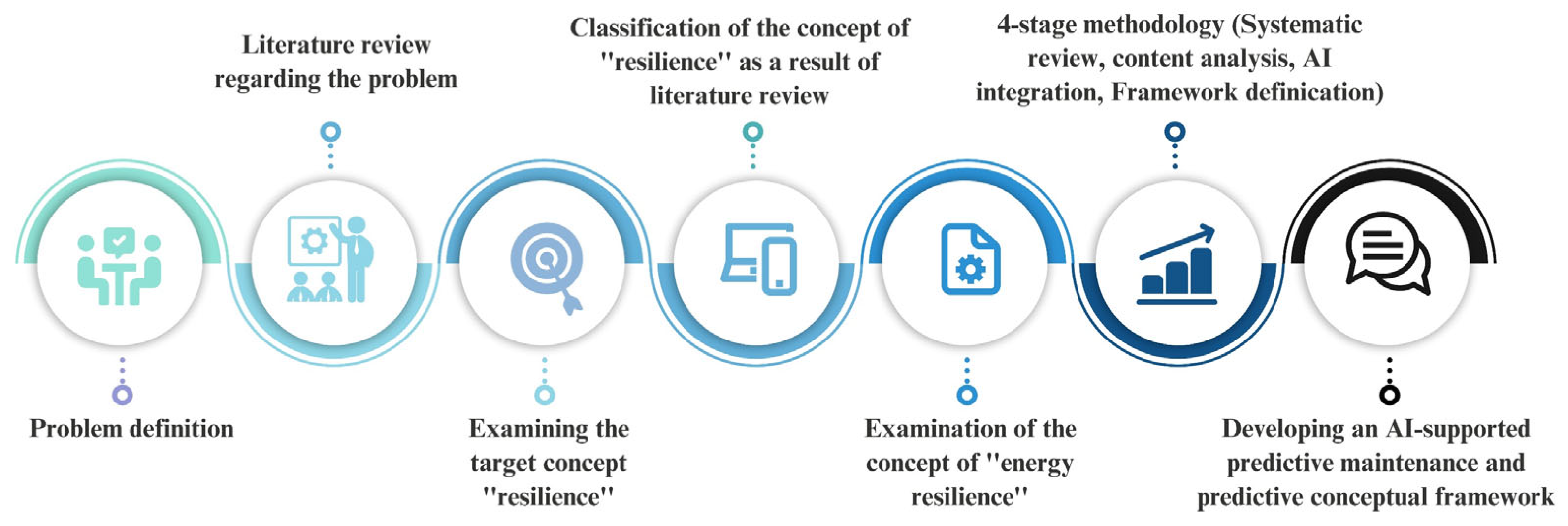



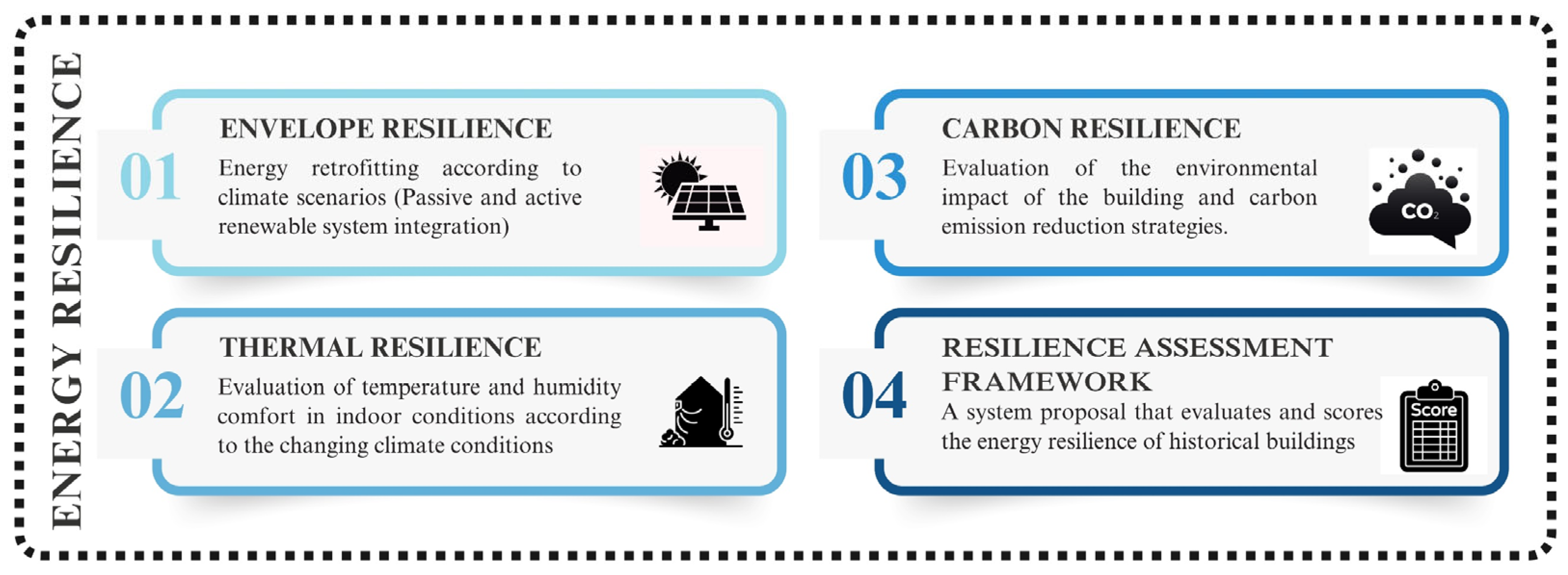

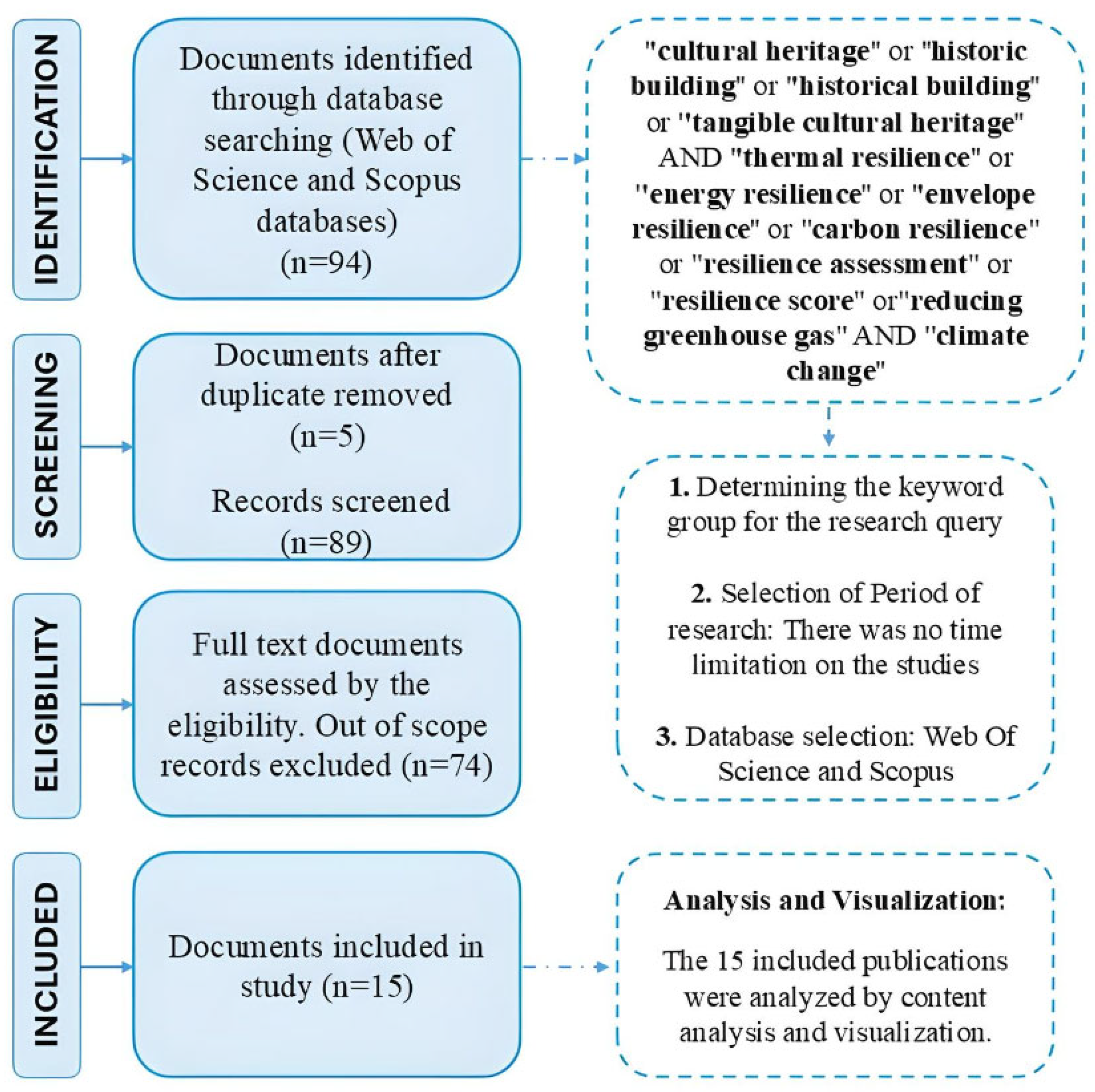
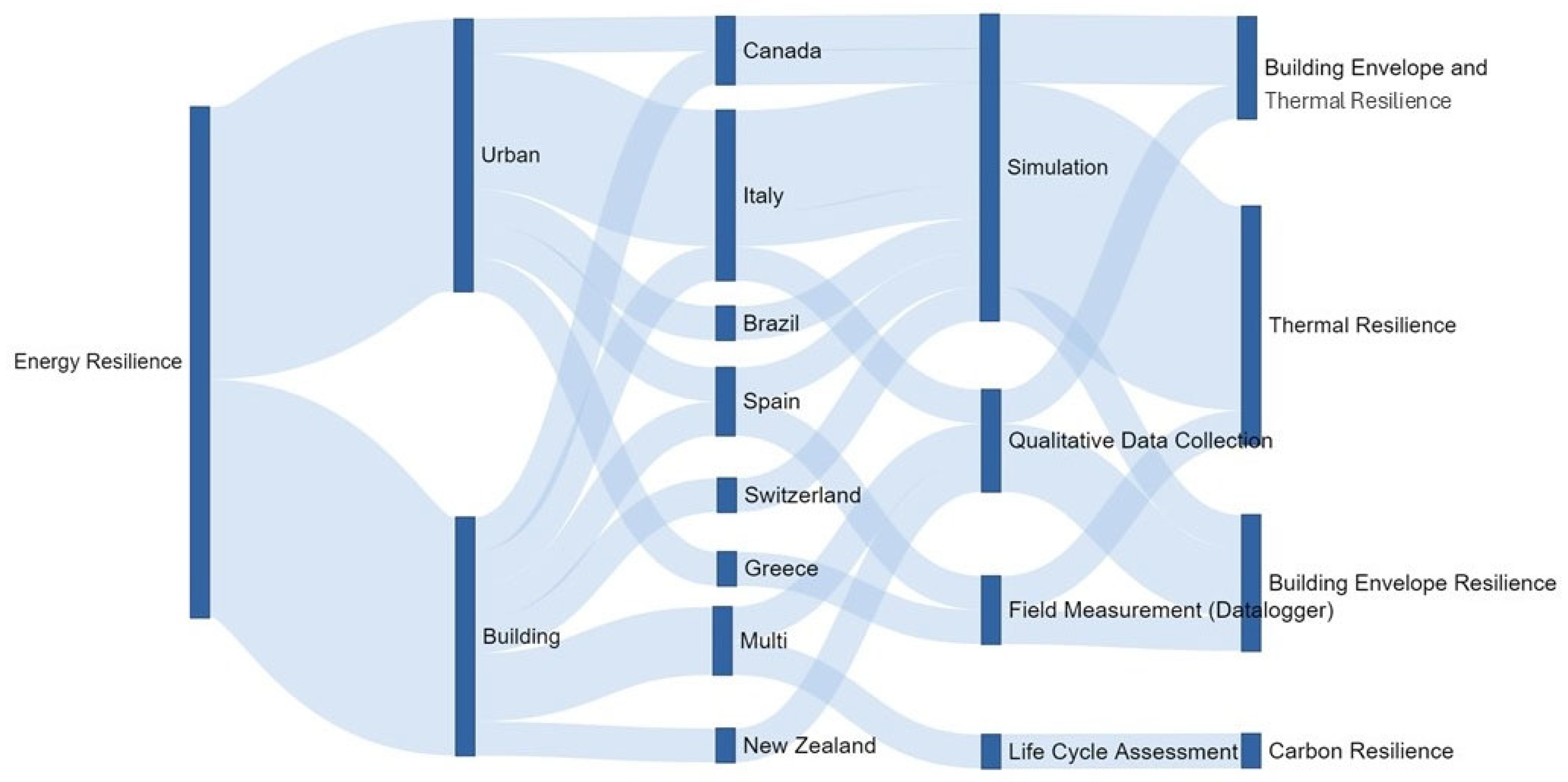
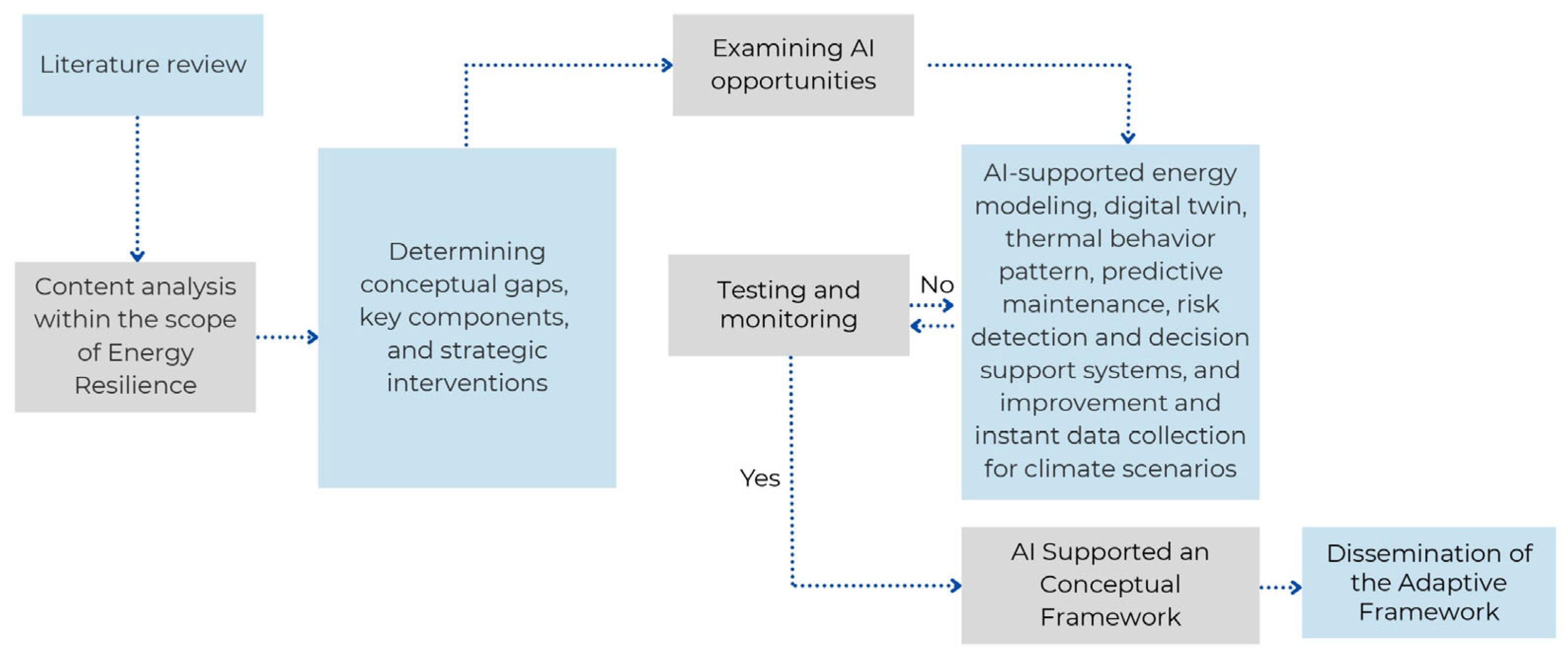
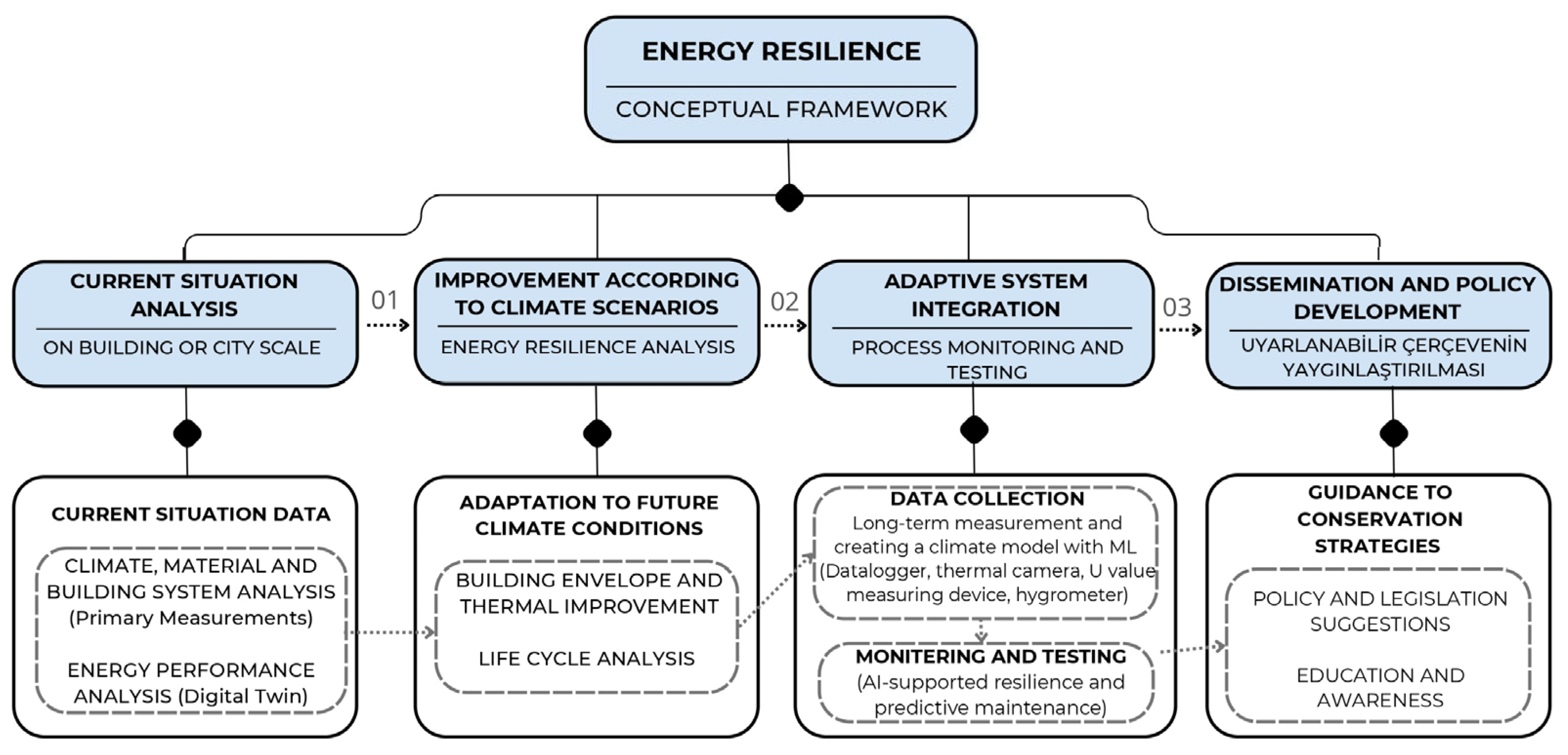
| Climate Change | Risks | Potential Impacts on Cultural Heritage | |
|---|---|---|---|
| The rise in global temperatures |
| Social | Urban neighbourhoods and historic buildings are abandoned; coastal metropolitan areas are evacuated because of soil erosion. |
| Economic and/or environmental | Decline in travel and associated activities; rise in energy consumption, and financial losses. | ||
| Physical | Material and structural deterioration (cracking, splitting, fungal growth, etc.). | ||
| Rise in heavy rainfall events |
| Social | Loss of identity and shared values, eviction, and progressive desertion as a result of inadequate comfort. |
| Economic and/or environmental | Increased energy demand and financial losses for insurance firms and/or estate administrators. | ||
| Physical | Material decay, moss formation, and structural damage due to increased load. | ||
| Rise in severe storms occurrences |
| Social | Loss of identity and shared values because of eviction and abandonment |
| Economic and/or environmental | Financial losses for insurance companies and/or estate administrators | ||
| Physical | Cultural heritage that has been partially damaged, lost, or destroyed | ||
| Reference | Scale | Case Study | Resilience Approach | Method | Aim | Findings and Conclusions |
|---|---|---|---|---|---|---|
| [15] | Urban | Scenario based on the Canadian climate | Building Envelope and Thermal Resilience | Simulation, Thermal and hygrothermal measurements) | Determines how climate change affects the performance and resilience of building envelopes. | With its adaptive design to different climatic conditions, the study can be a tool for performance prediction in the upcoming climate change. |
| [77] | Building | Barcelona residential buildings | Thermal Resilience | Simulation | Analyzes how the behaviour of buildings will change in scenarios where extreme temperatures are predicted to increase in summer. | Shows that overheating reduces thermal endurance in ventilation scenarios and affects the comfort of the air conditioner. |
| [16] | Building | Le Corbusier’s modern architecture buildings | Building Envelope and Thermal Resilience | Simulation | Develops energy and indoor environmental quality solutions by analyzing Le Corbusier’s studio apartment. | Adaptive strategies were found to be important in increasing resilience in buildings against climatic conditions. |
| [78] | Urban | Gubbio/İtaly Palazzo dei Consoli | Thermal Resilience (indoor and outdoor) | Field Monitoring and Simulation | Provides an approach for heritage sites by combining field monitoring and numerical modelling. | It reveals that the proposed analysis helps understand the impact of cultural heritage on indoor and outdoor spaces. |
| [28] | Urban | Molfetta Historical District/Italy | Envelope Resilience | Data collection and the Geographical clustering method | Analyzes and quantify process hazards and plan strategic actions to reduce hazards. | The management system in the study’s strategy seems helpful in defining actions and analysing each case study. |
| [29] | Urban | Athens Historical Centre/Greece | Thermal Resilience | Thermal Sensation-Ginovi method, Discomfort Index | Develops a plan for how users can adapt to adverse thermal conditions. | Develops a feasible climate change resilience plan to assess the impacts of urban warming. |
| [79] | Urban | 92 structures in Florianopolis, Brazil | Thermal Resilience | Simulation and resilience assessment method | Evaluates the thermal resilience of heritage to assess the risk of indoor overheating. | Reveals the necessity of strategies developed for adaptive design in resilience planning. |
| [80] | Building | Review of various buildings in New Zealand | Building Envelope and Thermal Resilience | Examining strategies through qualitative research | Assesses energy and seismic resilience through current policies and practices. | Emphasizes the importance of integrated approaches to energy and seismic retrofitting. |
| [81] | Urban | Open spaces in Campi, Venice | Thermal Resilience (outdoor) | Simulation and Physiological Equivalent Analysis | Provides improvements to enhance the thermal comfort of urban areas. | Contributes to assessing and strengthening heritage based on climate change. |
| [41] | Building | Casa dell’Angelo/İtaly | Thermal Resilience (indoor) | On-site monitoring and Simulation | Proposes responsive renovation strategies to increase the resilience of historic buildings. | Shows that microclimate-controlled air conditioning systems reduce energy consumption. |
| [82] | Urban | Historic residences in the Cádiz region | Building Envelope Resilience | Monitoring and data collection in the field (data logger, sensors) | Examines bioclimatic design approaches and how the city will adjust to changing climate conditions. | Shows that historic dwellings are climate-adapted and have potential for improvement. |
| [83] | Urban | Mediterranean region/Italy | Building Envelope Resilience | Simulation and in situ measurement | Develops an approach that includes energy retrofitting, transformations, and conservation. | Investigates the role of compactness, light-colored materials, and roofs against microclimate changes. |
| [84] | Building | United Kingdom/China (industrial buildings) | Carbon Resilience | Quantitative review through Life Cycle Analysis | Advocates for the need and guidelines for including embodied carbon. | Shows the contribution of the inclusion of embodied carbon to potential carbon savings. |
| [85] | Building | Vancouver, Ottawa, Charlottetown/Canada | Thermal Resilience | Simulation and resilience measurements | Provides practitioners with an assessment framework for building resilience. | Contributes to developing building codes for climate change-compatible infrastructures. |
| [67] | Building | A review of studies in the literature | Building Envelope Resilience | Analysis of strategies based on hydrophilic characteristics | Assesses the moisture compatibility of façade renovation and insulation materials. | Emphasizes the importance of moisture compatibility of thermal insulation materials in façade renovation. |
Disclaimer/Publisher’s Note: The statements, opinions and data contained in all publications are solely those of the individual author(s) and contributor(s) and not of MDPI and/or the editor(s). MDPI and/or the editor(s) disclaim responsibility for any injury to people or property resulting from any ideas, methods, instructions or products referred to in the content. |
© 2025 by the authors. Licensee MDPI, Basel, Switzerland. This article is an open access article distributed under the terms and conditions of the Creative Commons Attribution (CC BY) license (https://creativecommons.org/licenses/by/4.0/).
Share and Cite
Öztürk, B.; Selçuk, S.A.; Arayici, Y. An AI-Supported Framework for Enhancing Energy Resilience of Historical Buildings Under Future Climate Change. Architecture 2025, 5, 63. https://doi.org/10.3390/architecture5030063
Öztürk B, Selçuk SA, Arayici Y. An AI-Supported Framework for Enhancing Energy Resilience of Historical Buildings Under Future Climate Change. Architecture. 2025; 5(3):63. https://doi.org/10.3390/architecture5030063
Chicago/Turabian StyleÖztürk, Büşra, Semra Arslan Selçuk, and Yusuf Arayici. 2025. "An AI-Supported Framework for Enhancing Energy Resilience of Historical Buildings Under Future Climate Change" Architecture 5, no. 3: 63. https://doi.org/10.3390/architecture5030063
APA StyleÖztürk, B., Selçuk, S. A., & Arayici, Y. (2025). An AI-Supported Framework for Enhancing Energy Resilience of Historical Buildings Under Future Climate Change. Architecture, 5(3), 63. https://doi.org/10.3390/architecture5030063






